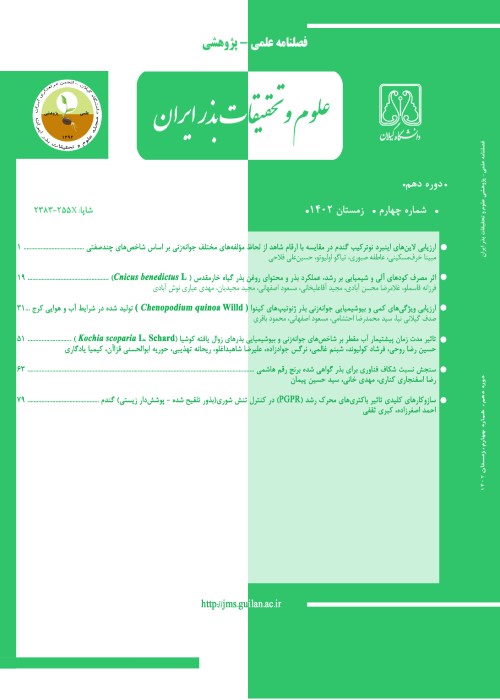Investigation of constituents and antifungal effects of essential oils of native cumin seed populations on seed-borne fungi
Author(s):
Article Type:
Research/Original Article (دارای رتبه معتبر)
Abstract:
The seed is one of the most important inputs of agricultural products that its quality and health can be affected by seed-borne fungi. The aim of this study was to identify the seed-borne fungi and their effect on germination and vigor indices of native cumin seed populations and also to evaluate the effects of essential oils and constituents of essential oils these seed populations on seed-borne fungi isolated. In order to identify of seed-borne fungi of cumin seed populations from seeds produced in fields of Mashhad, Fariman, Kashmar and Quchan in Khorasan Razavi province were sampled according to the International Rules for Seed Testing (ISTA). After isolation and purification, fungal isolates were identified based on morphological and molecular characteristics. Also, pathogenicity potential and the aggressiveness of isolates on seedlings were investigated. A total of 12 isolates were identified based on morphological and molecular characteristics that belonging to Fusarium oxysporum and F. solani species. The results of the standard germination test showed that there was a significant difference among the seed populations studied in the germination and vigor indices. Seed infected by seed-borne fungi significantly affects germination and vigor indices and reduces seed quality and health. The results showed that the highest vigor and germination indices were observed in Fariman seed population followed by Kashmar, Quchan and Mashhad seed populations. The results of pathogenicity test showed that about 41.7% of the isolates were pathogenic and 58.3% of the isolates were non-pathogenic. Also, different levels of pathogenicity and aggressiveness were observed for various isolates of Fusarium species. In the continuation of this research, the essential oil was extracted by hydrodistillation using a Clevenger apparatus and its major constituents were identified by gas chromatography-mass spectrometry. The main compounds identified essential oils included β-pinene, ρ-cymene, γ-terpinene and cuminic aldehyde. The results showed that the compounds of α-pinene, sabinene, β-pinene, myrcene, γ-terpinene, terpinen-4-ol, β-farnesene and carotol had antifungal effects against F. oxysporum isolates. Synergistic effects of the main constituents of essential oils showed that combing terpinen-4-ol with β-pinene induced a synergistic activity and combing terpinen-4-ol with γ-terpinene and also β-elemene with γ-terpinene caused an additive effect against were F. oxysporum isolates. This is the first report on the effect of essential oil compositions of native cumin seed populations on seed-borne fungi isolated from the same seeds. The findings of this research showed that amount and the type of constituents of essential oils of cumin seed populations are different and it can affect the abundance of seed-borne fungi and their level of pathogenicity.
Keywords:
Language:
Persian
Published:
Iranian Journal of Seed Science and Research, Volume:8 Issue: 4, 2022
Pages:
325 to 351
magiran.com/p2387683
دانلود و مطالعه متن این مقاله با یکی از روشهای زیر امکان پذیر است:
اشتراک شخصی
با عضویت و پرداخت آنلاین حق اشتراک یکساله به مبلغ 1,390,000ريال میتوانید 70 عنوان مطلب دانلود کنید!
اشتراک سازمانی
به کتابخانه دانشگاه یا محل کار خود پیشنهاد کنید تا اشتراک سازمانی این پایگاه را برای دسترسی نامحدود همه کاربران به متن مطالب تهیه نمایند!
توجه!
- حق عضویت دریافتی صرف حمایت از نشریات عضو و نگهداری، تکمیل و توسعه مگیران میشود.
- پرداخت حق اشتراک و دانلود مقالات اجازه بازنشر آن در سایر رسانههای چاپی و دیجیتال را به کاربر نمیدهد.
In order to view content subscription is required
Personal subscription
Subscribe magiran.com for 70 € euros via PayPal and download 70 articles during a year.
Organization subscription
Please contact us to subscribe your university or library for unlimited access!


